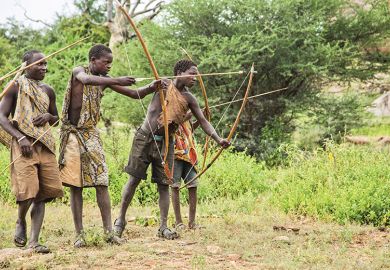Norman Hammond travels creative caves and Tarantino-esque towns.
In Mussorgsky's Pictures at an Exhibition , the musico-visual vignettes of Victor Hartmann's paintings are linked by a "promenade", representing viewers as they progress from exhibit to exhibit. In After the Ice Steven Mithen uses a timewalker called John Lubbock similarly to link his imaginative episodes across the miles and the millennia. Named for the first Lord Avebury, whose Prehistoric Times (1865) was the first attempt to encyclopaedise archaeology, the conceit leads to occasional clumsiness when "modern John Lubbock" and "Victorian John Lubbock" inhabit the same paragraph; but on the whole it works.
Mithen's scope is worldwide; his chosen 15,000 years begin in the frigid depths of the Late Glacial Maximum, when so much of the world's water was frozen into icecaps that sea level fell hundreds of feet, linking continents and islands with broad plains. People hunted, fished and collected plant foods - women contributing most of the calories, men the occasional packet of high-grade protein and tall stories of the mammoth that got away. Cave artists envisioned this in imaginative outpourings from Lascaux to Australasia: these people may have had simple economies and technologies, but their minds were as sharp as ours.
The story ends in 5,000BC, with farming villages spread across much of the Old World - wheat and barley from Egypt to India, rice in China - and the cultivation of maize and root crops becoming established from Mexico to Peru: societies creating surplus that became launch pads for the emergence of civilisation. In between, we get a whistle-stop tour of Asia, Europe, the Americas and Africa, beginning on the shores of the Sea of Galilee as the hunters of Ohalo see their campsite burn to the ground almost 20,000 years ago, and circling the globe to end among the farmers at Merimde in the Nile delta not long before the stirrings of Pharaonic Egypt.
Each episode in the advance of human society is based on a noted, often recently investigated site but the textbook names are there too. Thus, in covering western Asia, Lubbock visits Natufians in the Jordan valley at Ain Mallaha, dug from the 1950s onwards and documenting the moment when the commitment to agriculture had become one of no turning back. A sediment core from Lake Hula encoding environmental changes, Hayonim cave and the village of Abu Hureyra on the banks of the Euphrates bring the story to the foundation of Jericho, where perennial springs supported one of the first communities that we might call a town (although Ofer bar-Yosef has shown that the walls were probably protection against mud-flows rather than enemies).
While the social complexity implied by stout defences may no longer be seen in early Jericho, a similar degree of Neolithic ideological development has been documented by recent work at Göbekli Tepe in southeast Turkey, where massive stone pillars were carved out of bedrock, decorated with reliefs of wild animals and erected in semisubterranean shrines. The largest of these pillars would have weighed 50 tonnes: but this mountain sanctuary was built 11,000 years ago by people who were still hunters of game and collectors of wild plants.
Çatal Höyük has been among the most famous Neolithic sites since James Mellaart first uncovered its densely packed houses with their animal-ornamented shrines 40 years ago, and the image of "the first town" has always been vaguely positive, an agricultural society progressing towards civilisation. Mithen takes a different view, of "the nightmare vision of the world that farming has brought": Lubbock stumbles through a phantasmagoria of breasts bursting forth the skulls of vultures and weasels, "motherhood violently defiled... people trapped within a bestiary from which they cannot escape". Ian Hodder's excavations are proving more enlightening, though less Tarantino-esque.
Lubbock eventually makes his way, via post-glacial Europe, through the Americas and on to Australia: most of the important recently studied sites are here, from Monte Verde and Meadowcroft to Guilá Naquitz and Koster, Cuddie Springs to Kow Swamp. Mithen takes a conservative view of the First Americans debate, accepting little before 12,500BC, although the basis for his scepticism, as also for the early dates for Australia from sites in the far north such as Malakunanja II, lies buried in the extensive endnotes. Controversies over the disposition of early human remains - Kennewick Man, and the seizure of the Kow Swamp skeletons by government fiat - are lightly touched on, but the endnotes and references allow these and many other academic disputes to be followed back through the literature.
East and South Asia, with early farmers growing rice at Pengtoushan and barley at Mehrgarh, the first potters producing their wares at Odaiyamamoto - probably driven by social competition, perhaps the need for fermented-liquor vessels to service chiefly hospitality, more than by housewifely necessity - and vulture dancers strutting their stuff at Zawi Chemi Shanidar like the later crane dancers of Çatal Höyük, form part of Lubbock's tour d'horizon as he makes for Africa, the first and last continent. Given that most of the important sites he needs to discuss are caves, and that for a general audience one cave goes a long way, Mithen manages to keep the pace up. He is helped by a set of colour plates provided by the excavators themselves, showing archaeology in action. In the picture of Wadi Faynan site 16, south of the Dead Sea in Jordan, the author himself anonymously excavates a house some ten millennia old.
Although After the Ice is a valuable conspectus of what we know about the beginnings of our world of settlement and city, Mithen has been badly served by his proofreader: the names of sites and even of prominent archaeologists are misspelt and there are homophonic solecisms ("slither" for "sliver", "critique" for "critic"); other lapses include placing the important Mesolithic site of Lepenski Vir in Slovenia instead of Serbia, and the cave of Palli Aike in the sea off Cape Horn. A professional reader will ignore these, but the general audience must take what he says on trust. There will doubtless be a paperback edition: shorn of these errors, it deserves success commensurate with Lubbock's effortful travels through time.
Norman Hammond is professor of archaeology, Boston University, Massachusetts, US.
After the Ice: A Global Human History, 20,000-5,000 BC
Author - Steven Mithen
Publisher - Weidenfeld and Nicolson
Pages - 622
Price - £25.00
ISBN - 0 297 64318 5
Register to continue
Why register?
- Registration is free and only takes a moment
- Once registered, you can read 3 articles a month
- Sign up for our newsletter
Subscribe
Or subscribe for unlimited access to:
- Unlimited access to news, views, insights & reviews
- Digital editions
- Digital access to THE’s university and college rankings analysis
Already registered or a current subscriber?



